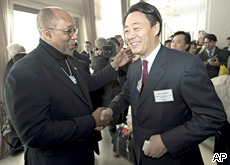As there has been some incorrect and/or incomplete information being circulated regarding the details of the Fukushima Nuclear Power Plants in this post I have translated the vital details of the various reactors of both Fukushima Plant #1 and #2 from their official profile pages at the Tokyo Power Company (which is their owner) website.
Apologies for the bizarre amount of white space, something wacky with the table HTML I can’t fix now, but the information itself is completely legible.
In both tables, the numbered columns refer to the individual reactors of the plants. For example, Plant #1, Reactor #1, etc.
Profile of Fukushima Nuclear Power Plant Number One: (福島第一原子力発電所)
This was the first nuclear power plant build and operated by the company. It covers an area 75 times as large as Tokyo Dome, about 350,000 square meters.
Reactor #1
| #1 | #2 | #3 | #4 | #5 | #6 | |||
C O R E S |
Output(万kW) | 46.0 | 78.4 | 78.4 | 78.4 | 78.4 | 110.0 | |
| Construction start | 1967/9 | 1969/5 | 1970/10 | 1972/9 | 1971/12 | 1973/5 | ||
| 1971/3 | 1974/7 | 1976/3 | 1978/10 | 1978/4 | 1979/10 | |||
| Reactor type | Boiling Water Reactor(BWR) | |||||||
| Containment Vessel | Mark I | マークII | ||||||
| % made in Japan | 56 | 53 | 91 | 91 | 93 | 63 | ||
| Primary contractor | GE | GE・Toshiba | Toshiba | Hitachi | Toshiba | GE・Toshiba | ||
| R E A C T O R |
Heat output(10,000s kW) | 138 | 238.1 | 329.3 | ||||
| Fuel assemblies(#) | 400 | 548 | 764 | |||||
| Fuel assemblies(length in m) | ~4.35 | ~4.47 | ~4.47 | |||||
| Control Rods(#) | 97 | 137 | 185 | |||||
| Pressure vessel | Gauge(m) | ~4.8 | ~5.6 | 約6.4 | ||||
| Total height(m) | ~20 | ~22 | 23 | |||||
| Total weight(metric tons) | 440 | 500 | 750 | |||||
| Container vessel | Total height(m) | ~32 | ~33 | ~34 | ~48 | |||
| Cylinder diameter(m) | ~10 | ~11 | ~10(Upper part) | |||||
| Spherical diameter(m) | ~18 | ~20 | ~25(Lower part) | |||||
| Pressure control pool volume(metric tons) | 1,750 | 2,980 | 3,200 | |||||
T U R B I N E |
Rotation speed (rpm) | 1,500 | ||||||
| Intake steam temp(℃) | 282 | |||||||
| Steam pressure(kg/cm2g) | 66.8 | |||||||
F U E L |
Type | Uranium dioxide | ||||||
| Uranium capacity(t) | 69 | 94 | 132 | |||||
| Fuel assemblies(#) | 400 | 548 | 764 | |||||
Profile of Fukushima Nuclear Power Plant Number Two: (福島第二原子力発電所)
| #1 | #2 | #3 | #4 | |||
| C O R E S
|
Electrical output(10,000 kW) | 110.0 | 110.0 | 110.0 | 110.0 | |
| Construction start | 1975/11 | 1979/2 | 1980/12 | 1980/12 | ||
| Operation start | 1982/4 | 1984/2 | 1985/6 | 1987/8 | ||
| Reactor type | Boiling Water Reactor(BWR) | |||||
| Containment Vessel | Mark II | Mark II revised | ||||
| % made in Japan | 98 | 99 | 99 | 99 | ||
| Primary Contractor | Toshiba | Hitachi | Toshiba | Hitachi | ||
| R E A C T O R |
Heat output(10,000 kW) | 329.3 | ||||
| Fuel assemblies(#) | 764 | |||||
| Fuel assembly total height(m) | ~4.5 | |||||
| Control Rods(#) | 185 | |||||
| Pressure Vessel | Gauge(m) | ~6.4 | ||||
| Total height(m) | ~23 | |||||
| Total weight (metric tons) | ~750 | |||||
| Container vessel | Total height(m) | ~48 | ||||
| Diameter(m) | ~26 | ~29 | ||||
| Pressure control pool volume (metric tons) | 3,400 | 4,000 | ||||
T U R B I N E |
Rotational speed(rpm) | 1,500 | ||||
| Input steam temp(℃) | 282 | |||||
| Steam pressure(kg/cm2g) | 66.8 | |||||
| F U E L |
Type | Uranium Dioxide | ||||
| Uranium capacity(metric tons) | 132 | |||||
| Fuel assemblies(#) | 764 | |||||
| B U I L D I N G |
Nuclear reactor building | Height ~58m、subsurface depth~18m(6 surface floors, 2 basement levels) | ||||
| Turbine building | Height above ground ~33m、subsurface depth ~5m | |||||
| Waste treatment building(Shared facility) | Height ~41m、subsurface depth ~18m(6 surface floors, 2 basement levels) | |||||
| Central exhaust tower | Height ~120m、altitude ~150m | |||||








